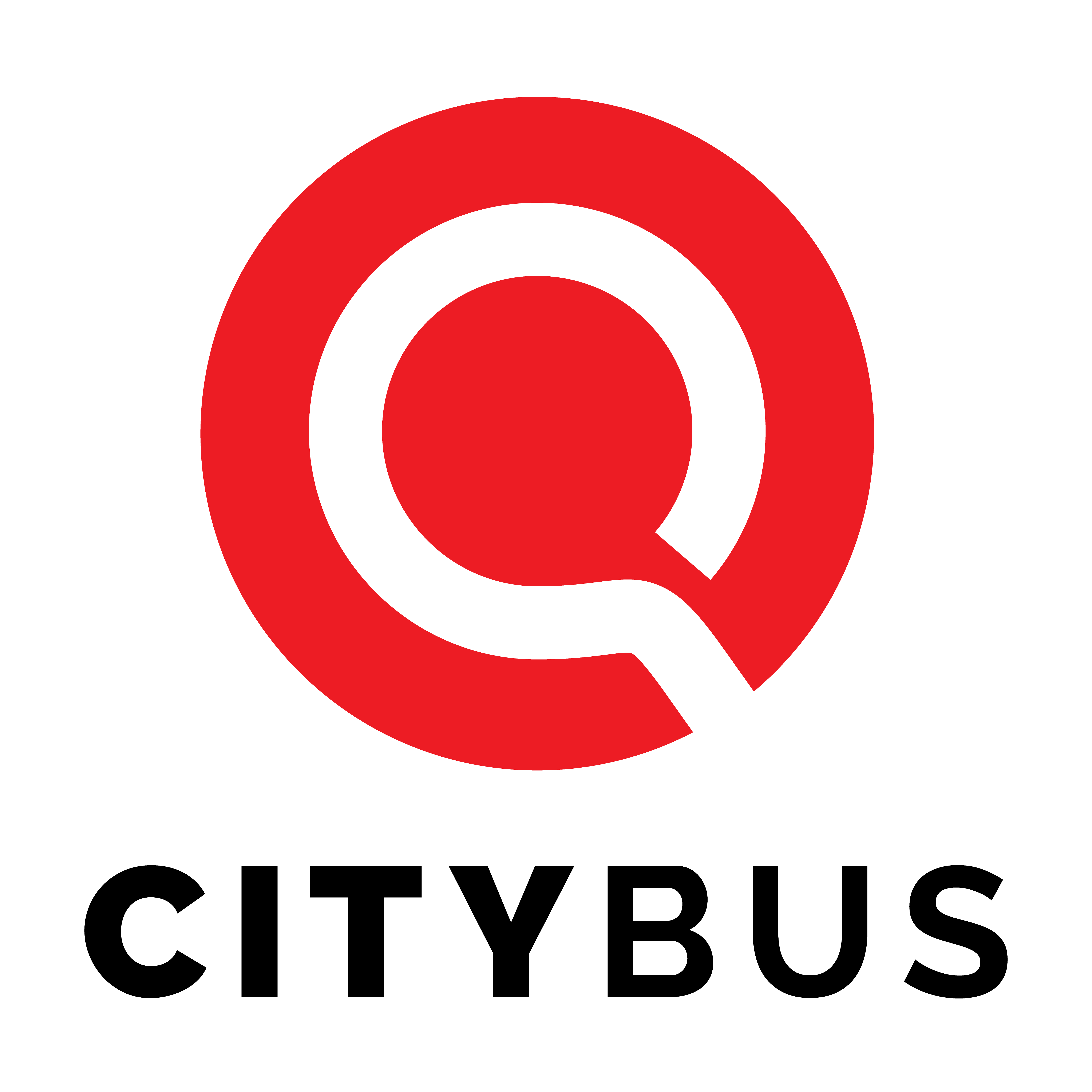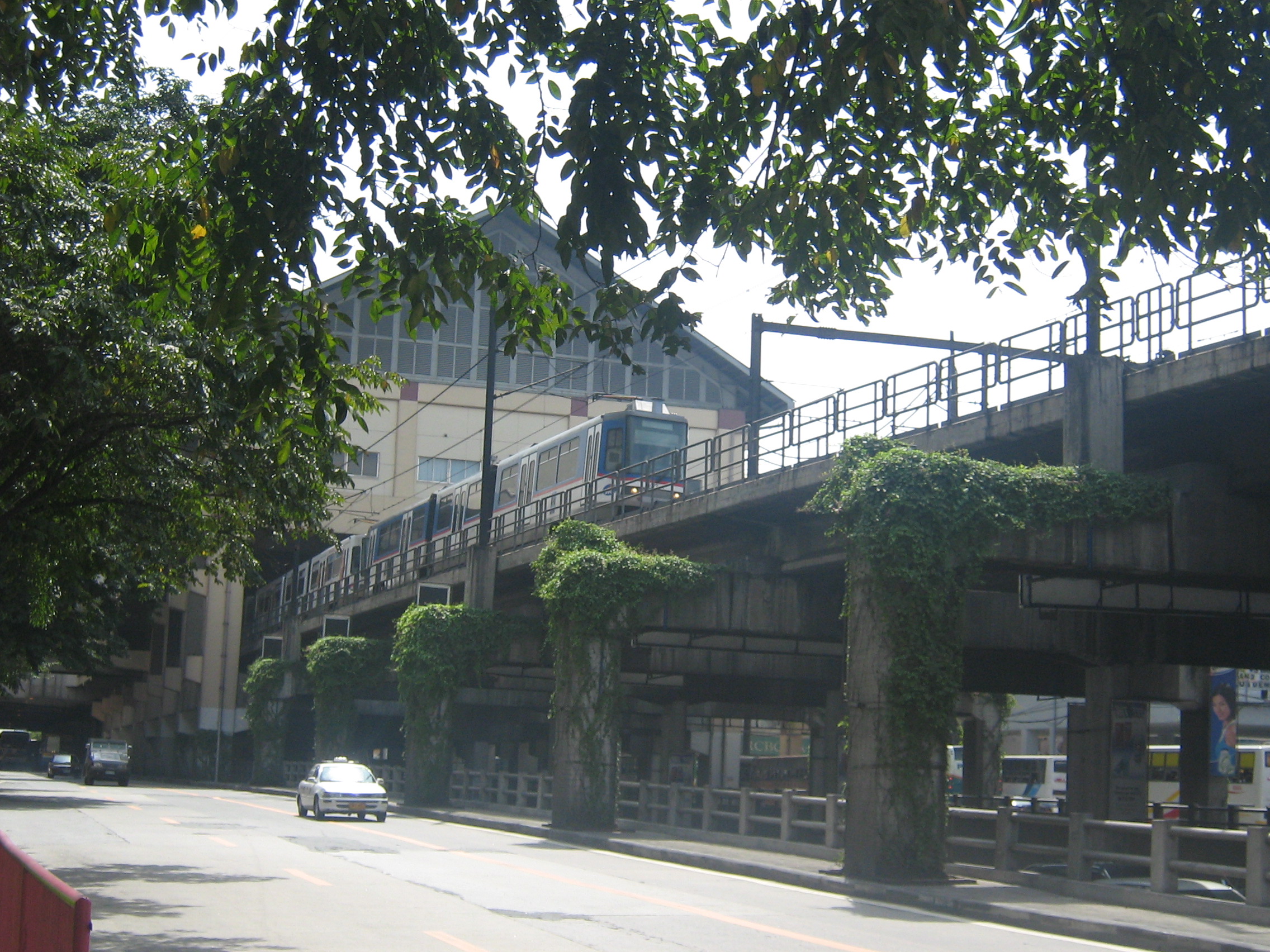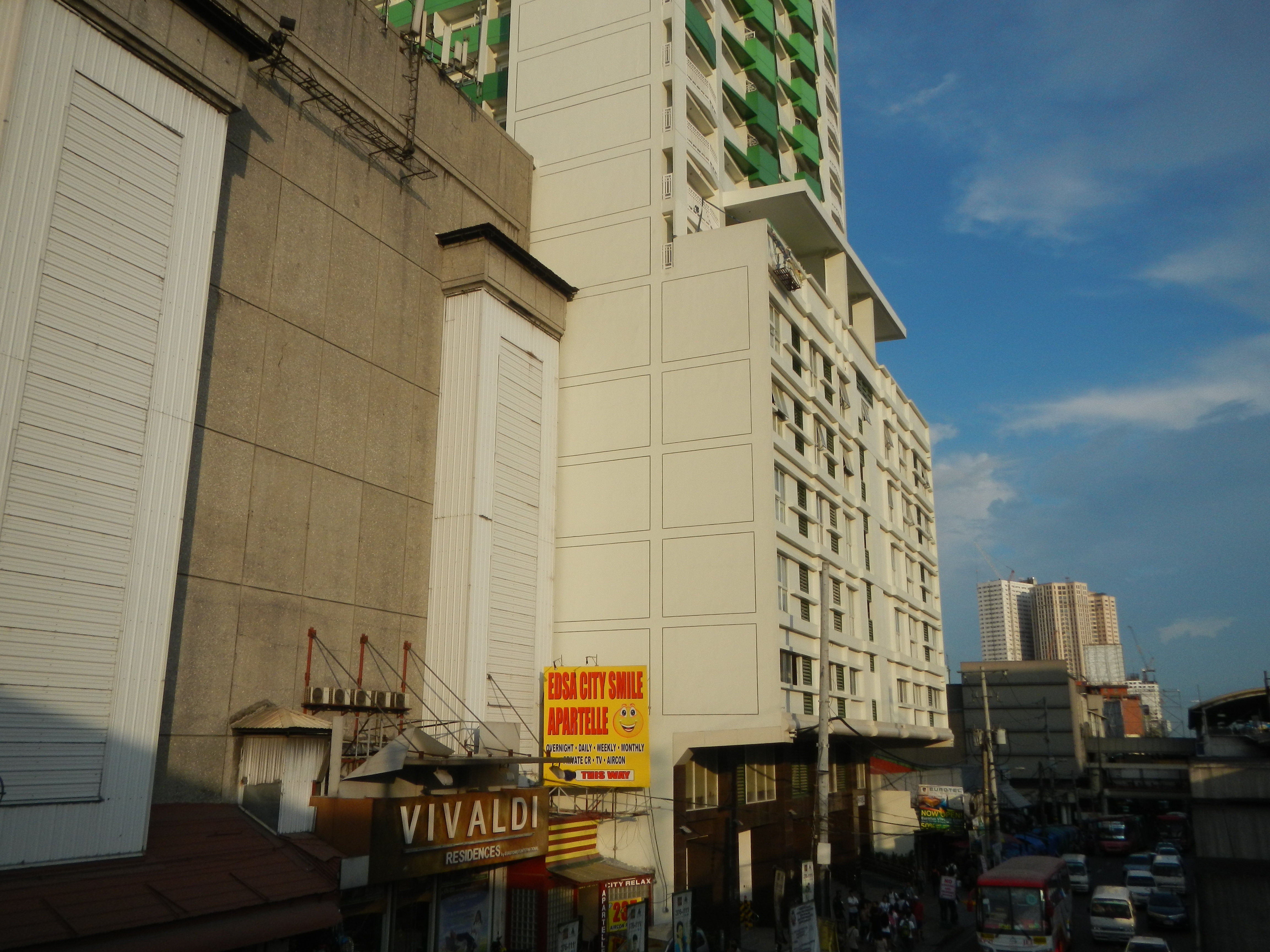|
Araneta Center–Cubao Station (MRT)
Araneta Center–Cubao station (also called Araneta–Cubao station or simply Cubao station) is an elevated Manila Metro Rail Transit (MRT) station situated on Line 3. The station is located in Cubao in Quezon City and is named after the old name of the Araneta City, a mixed-used development in the city. The station is the fourth station for trains headed to Taft Avenue and the tenth station for trains headed to North Avenue. It is one of five stations on the line where passengers can catch a train going in the opposite direction without paying a new fare due to the station's layout. The other four stations are Shaw Boulevard, Boni, Buendia, Ayala, and Taft Avenue. It is also the only station on the line with its concourse level located below the platform. Nearby establishments The most recognizable landmark that the station is located at is Araneta City, which hosts shopping malls such as Gateway Mall, Ali Mall, and Farmers Plaza. The Araneta City complex is also host an ... [...More Info...] [...Related Items...] OR: [Wikipedia] [Google] [Baidu] |
EDSA
Epifanio de los Santos Avenue, commonly referred to by its acronym EDSA, is a limited-access circumferential highway around Manila, the capital city of the Philippines. It passes through 6 of Metro Manila's 17 local government units or cities, namely, from north to south, Caloocan, Quezon City, San Juan, Metro Manila, San Juan, Mandaluyong, Makati, and Pasay. Named after academic Epifanio de los Santos, the road links the North Luzon Expressway at the Balintawak Interchange in the north to the South Luzon Expressway at the Magallanes Interchange in the south, as well as the major financial districts of Makati Central Business District, Ortigas Center, and Araneta City. It is the longest and the most congested highway in the metropolis, stretching some . Structure The entire avenue forms part of Circumferential Road 4 (C-4) of Metro Manila's arterial road network, National Route 1 (N1) of the Philippine highway network and Asian Highway 26 (AH26) of the Asian Highway Network, ... [...More Info...] [...Related Items...] OR: [Wikipedia] [Google] [Baidu] |
Shaw Boulevard Station
Shaw Boulevard station (also called Shaw for short) is an elevated Manila Metro Rail Transit (MRT) station situated on Line 3. The station is located in the Mandaluyong portion of Ortigas Center and is named after Shaw Boulevard, since the station lies directly above the boulevard. Being at the center of the whole line, many commuters regard Shaw Boulevard station as the "central terminal" of the line. The station is the seventh station for trains headed to Taft Avenue and North Avenue. It is one of five stations on the line where passengers can catch a train going in the opposite direction without paying a new fare due to the station's layout. The other four stations are Araneta Center-Cubao, Boni, Buendia, Ayala, and Taft Avenue. Excluding Araneta Center-Cubao station, it is also one of four stations on the line with its concourse level located above the platform. Station layout Shaw Boulevard station is the only station on the line with 3 tracks; with 1 reserve track used ... [...More Info...] [...Related Items...] OR: [Wikipedia] [Google] [Baidu] |
MRTC 3000 Class
The MRTC 3000 class or ČKD Tatra RT8D5M LRV, also known as Tatra Train, is a class of high-floor light rail vehicles built by Czech tram manufacturer ČKD Tatra. It is currently used on the Manila MRT Line 3 and were the last made by ČKD Tatra before it was taken over by Siemens. ČKD Tatra RT8D5M LRVs are owned by Metro Rail Transit Corporation (MRTC), and operated by the Department of Transportation (DOTr) thru DOTr MRT-3. Purchase The Manila MRT Line 3 construction began in 1996 when the then-Department of Transportation and Communications (DOTC; later the Department of Transportation) entered into a build-lease-transfer agreement with the Metro Rail Transit Corporation (MRTC). MRTC signed a contract with ČKD Tatra in 1997 to supply the trains for the line. Aside from a prototype, 73 light rail cars are produced by ČKD in two batches; 49 were produced in 1998 and the other 24 were completed the following year. The first train was flown into Manila via plane whil ... [...More Info...] [...Related Items...] OR: [Wikipedia] [Google] [Baidu] |
Vivaldi Residences Cubao
The Vivaldi Residences Cubao is a 40-storey mixed use residential, condotel tower located at the corner of EDSA and Aurora Blvd. in Quezon City, Philippines. The tower was named after Antonio Vivaldi, and is both owned and developed by Euro Towers International Inc.. serving as the company's first high-rise residential project in Metro Manila. History Before the construction of the project was established, the tower formerly sits on the former Ocean Theater, an old movie theater which opened in the area in the 1970s, and was closed in the 1990s, due to rising competition from malls, equipped with movie theaters and additional retail stores within Metro Manila. The theater was eventually auctioned for ownership in 2008, at a price tag of ₱58 million, with many companies bidding for the ownership of the property. The companies involved in the bidding for the property are SM Prime, First View Corp., and Eurotel. On November 18, 2008, Eurotel won the sale for the property, offerin ... [...More Info...] [...Related Items...] OR: [Wikipedia] [Google] [Baidu] |
Araneta Center–Cubao Station (Line 2) , a station on the Manila Metro Rail Transit System Line 3 (Line 3)
{{Station disambiguation ...
Araneta Center–Cubao station may refer to: * Araneta Center–Cubao station (LRT), a station on the Manila Light Rail Transit System Line 2 (Line 2) * Araneta Center–Cubao station (MRT) Araneta Center–Cubao station (also called Araneta–Cubao station or simply Cubao station) is an elevated Manila Metro Rail Transit (MRT) station situated on Line 3. The station is located in Cubao in Quezon City and is named after the old na ... [...More Info...] [...Related Items...] OR: [Wikipedia] [Google] [Baidu] |
Manila Light Rail Transit System Line 2
The Light Rail Transit Line 2, also known as LRT Line 2 (LRT-2) or Megatren, is a rapid transit line in Metro Manila in the Philippines, generally running in an east–west direction along the Radial Road 6 and a portion of the Circumferential Road 1, referred to as the Purple Line, and previously known as the Mass Rapid Transit Line 2 or MRT Line 2 (MRT-2). Although the line is operated by the Light Rail Transit Authority, resulting in it being called as "LRT-2", it is actually a heavy rail, rapid transit line. Instead of the light rail vehicles used in earlier lines, it uses very large metro cars, longer and wider than those used on the PNR network, and roughly the same size as those used on the MTR in Hong Kong, MRT in Bangkok and Singapore, and the heavy metro lines of the Taipei Metro. Until the opening of MRT Line 7 (MRT-7) in 2022 and the Metro Manila Subway (MMS) in 2025, it is the country's only line using these types of trains. Envisioned in the 1970s as part of th ... [...More Info...] [...Related Items...] OR: [Wikipedia] [Google] [Baidu] |
Aurora Boulevard
Aurora Boulevard is a four-to-ten lane major thoroughfare in Quezon City and San Juan in Metro Manila, Philippines. It was named after Doña Aurora Quezon, the consort of Commonwealth President Manuel Luis Quezon. It is one of the major roads in the commercial district of Araneta City in Cubao. Line 2 follows the alignment of the boulevard. Route description Aurora Boulevard is divided into two routes, the Araneta Avenue to EDSA, and EDSA to Katipunan Avenue ( C-5). Most of the road is a 4-lane dual carriageway, with Line 2 having five stations above ground, while one (Katipunan station) is located underground. Aurora Boulevard starts as a physical extension of Ramon Magsaysay Boulevard past Araneta Avenue near the Manila-Quezon City boundary. It then enters San Juan before crossing Ermitaño Creek near Broadway Centrum to return to Quezon City, this time at the New Manila district. It then intersects Gilmore Avenue, Balete Drive, and E. Rodriguez Sr. Avenue, before it mee ... [...More Info...] [...Related Items...] OR: [Wikipedia] [Google] [Baidu] |
Epifanio De Los Santos Avenue
Epifanio de los Santos Avenue, commonly referred to by its acronym EDSA, is a limited-access circumferential highway around Manila, the capital city of the Philippines. It passes through 6 of Metro Manila's 17 local government units or cities, namely, from north to south, Caloocan, Quezon City, San Juan, Mandaluyong, Makati, and Pasay. Named after academic Epifanio de los Santos, the road links the North Luzon Expressway at the Balintawak Interchange in the north to the South Luzon Expressway at the Magallanes Interchange in the south, as well as the major financial districts of Makati Central Business District, Ortigas Center, and Araneta City. It is the longest and the most congested highway in the metropolis, stretching some . Structure The entire avenue forms part of Circumferential Road 4 (C-4) of Metro Manila's arterial road network, National Route 1 (N1) of the Philippine highway network and Asian Highway 26 (AH26) of the Asian Highway Network, while its westbound ... [...More Info...] [...Related Items...] OR: [Wikipedia] [Google] [Baidu] |
EDSA Carousel
The EDSA Carousel is a bus rapid transit (BRT) line that is part of the bus routes in Metro Manila. The line has an exclusive right-of-way on a dedicated bus lane called the EDSA Busway which is separated from the normal road traffic in EDSA by concrete barriers and steel bollards. Interim operations began on June 1, 2020, serving as a replacement of the former bus routes along EDSA, acting as an augmentation service to the MRT Line 3 due to the limited capacity restrictions put in place by the general community quarantine in Metro Manila as a result of the COVID-19 pandemic in the Philippines. Full operations began later on July 1, 2020. Intended to be largely served by bus stops along the median, some stops are temporarily served by bus stops on the curbside. The line is operated by the Mega Manila Consortium Corporation and ES Transport and Partners Consortium under the supervision of the Department of Transportation (DOTr) and Metropolitan Manila Development Authority (M ... [...More Info...] [...Related Items...] OR: [Wikipedia] [Google] [Baidu] |
Smart Araneta Coliseum
The Araneta Coliseum, also currently known by naming rights sponsorship as Smart Araneta Coliseum, is an indoor multi-purpose arena, sports arena that is part of the Araneta City in the Cubao area of Quezon City, Philippines. Nicknamed as "the Big Dome", it is one of the largest indoor arenas in Asia, and it is also one of the largest clear span domes in the world. The dome measures approximately making it the largest dome in Asia from its opening in 1960 until 2001 when it was surpassed by the Ōita Stadium in Japan with a dome measuring . The Smart Araneta Coliseum is mostly used for indoor sports such as basketball and volleyball. It is a main venue of the Philippine Basketball Association and for the basketball games of the National Collegiate Athletic Association (Philippines), National Collegiate Athletic Association and the University Athletic Association of the Philippines throughout various game seasons. The Big Dome is also used for other sports and events such as box ... [...More Info...] [...Related Items...] OR: [Wikipedia] [Google] [Baidu] |
Ali Mall
Ali Mall is a shopping mall at the Araneta City in Cubao, Quezon City beside SM Cubao, and is owned by The Araneta City Inc. (ACI, Inc.), a subsidiary of the Araneta Group. The first major shopping mall in the Philippines, the retail area was named in honor of boxer Muhammad Ali, and was built in 1976, making it one of the oldest malls in the country. History Construction on the mall began in 1975 after Muhammad Ali's boxing victory against Joe Frazier in Araneta Coliseum, dubbed "Thrilla in Manila". At the time there were no malls in the country, until J. Amado Araneta's son, Jorge Araneta, a member of the Araneta family laid plans to build a mall and name it after Ali in honor of his victory. Ali was overjoyed with the proposal and did not charge any royalty fees. The mall has a floor area of and was completed within the year. It was inaugurated on June 30, 1976, with Ali himself attending the ceremony. The mall was designed by the architectural firm Sindiong-Ocampo, whe ... [...More Info...] [...Related Items...] OR: [Wikipedia] [Google] [Baidu] |
Gateway Mall (Araneta Center)
Gateway Mall is a shopping mall located within the Araneta City in Cubao, Quezon City, Philippines. Owned and operated by the Araneta City, Inc. (ACI, Inc.), a subsidiary of the Araneta Group, the mall was completed in 2004 and has of total floor area, while having of total land area. The Gateway Mall also currently sits on the northern area of the Araneta City, located at the northern end of the historic Araneta Coliseum and attracts over 220,000 shoppers daily, due to its close proximity to transport terminals and train stations. At present, the Gateway Mall is also currently undergoing an expansion project, known as the Gateway Mall 2, located along the western side of the Araneta Coliseum, and also includes the Ibis Styles Araneta City within the development. When completed, the mall will add of retail space, totaling the mall's retail floor area to , making the mall one of largest shopping malls in the Philippines upon completion in February 2023. History The present ... [...More Info...] [...Related Items...] OR: [Wikipedia] [Google] [Baidu] |





_(cropped).jpg)


(2017-08-13).jpg)